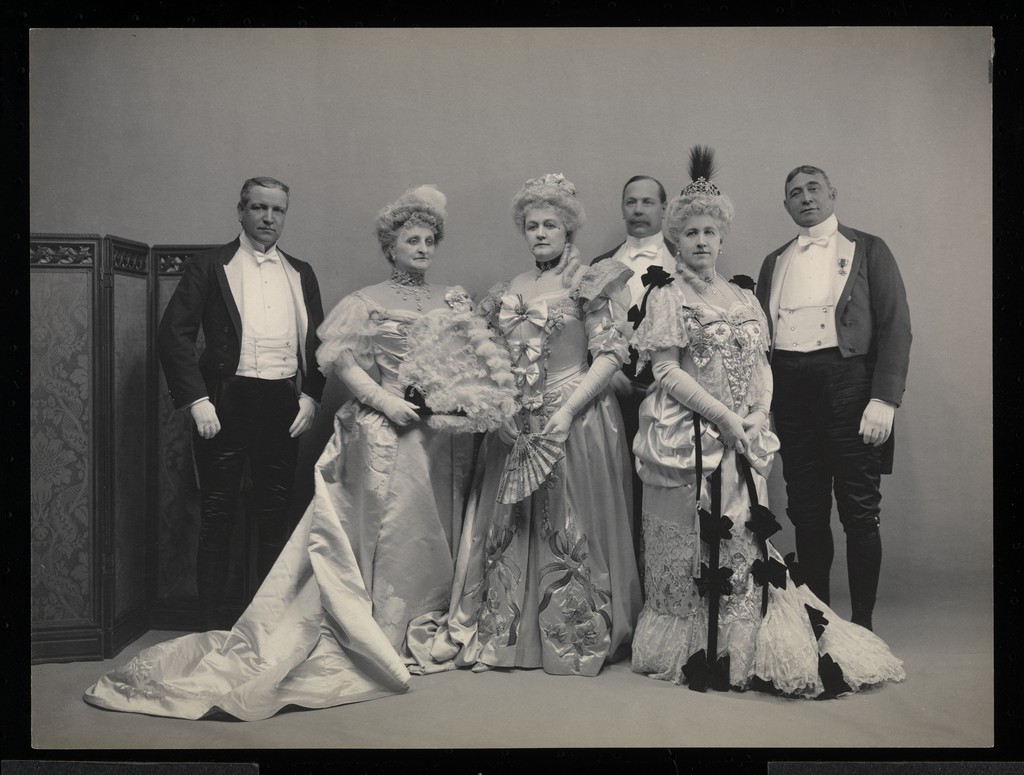Sometimes, to give a great party can be a dangerous thing. There have been parties whose immortality consisted in the fact that their very splendor brought down disaster upon their givers. That is, the greater the party, the greater the fall. …
In the severe depression winter of 1896-97 in New York, the Bradley Martins of high society threw a fabulous $300,000 ball in the newly completed Waldorf-Astoria Hotel, in the odd belief that the spreading of so much manna would alleviate the condition of the poor- and, when the Martin’s awoke next morning to find themselves called infamous, they sought permanent refuge in Europe.

—James L. Breese, at the Bradley-Martin Ball, 1897. Costumed as the Duc de Guise, his outfit was embroidered in pearls and silver. According to reports, swords like Breese’s gilt blade were a liability during dances, as few of the guests were experienced in carrying them.—Read More:http://hosttotheworld.com/omeka/items/show/535
In the next decade another bemused and lordly New Yorker, the insurance heir James Hazen Hyde, staged an even costlier affair at Sherry’s- a court soiree reproducing one of Louis XVI’s, with authentic stauary, settings,costumes and liveries, imported for the occasion, along with the actress Rejane-but which also led to Hyde’s long disappearance from his homeland, since his spending had helped trigger an investigation as to just what his Equitable Life Assurance Society was doing with its manna.
ADDENDUM:
(see link at end)…Mrs. Bradley-Martin’s grand fete: In 1896-’97, New York was in the midst of an economic panic. Thousands were unemployed and long bread lines formed on the streets. Cornelia Bradley-Martin was distressed over the misery she saw around her and suggested to her husband that an extravagant party might help to lift New York out of its slump. It not only would lift spirits, she thought, but also would employ out of-work florists, hair stylists and dressmakers. She decided the party should be a costume ball, with invitations sent on short notice so guests wouldn’t have time to buy their costumes overseas.
Her husband readily agreed, setting in motion plans for what would become one of the most publicized and controversial society events in New York history.
The Bradley-Martins selected Wednesday, Feb. 10, as the date and asked guests to dress “appropriately for the court of Versailles at the time of Louis XIV.” As soon as the party was announced, newspapers around the world began to print detailed accounts of the preparations. The New York Times told readers in detail how carloads of orchids and roses arrived to transform the Grand Ballroom of the Waldorf Astoria – site for the great party – into the Great Hall of Mirrors at Versailles.

— They also were frequent members in the court of St. James, at which Mrs. Alexander was always attired in a gown by Worth. One of the most famous parties they attended was The Bradley-Martin Ball held at the Waldorf-Astoria given at a cost of $9 million, one of the most expensive parties every held.
For The Bradley-Martin Ball Harriet Alexander Wore A Magnificent Costume Made By Callot Soeurs, Paris —Read More:http://thegildedageera.blogspot.ca/2012/07/mrs-charles-b-alexander-mansion-new.html
At 11 p.m. of the appointed evening, the first of 700 guests began to arrive. The guests were ushered into cozy dressing rooms where professional costumers and makeup artists stood ready to assist with the finishing touches. Then the guests were escorted into the throne room where the Bradley-Martins were seated, he costumed as Louis XV and she unexpectedly dressed as Mary, Queen of Scots, who ruled two centuries earlier. She complemented her costume of black velvet and white lace with a stunning collection of jewels, including some former French Crown Jewels. Three confirmed items were the pair of ruby and diamond bracelets dating from 1810 (which she wore joined together to form a dog collar), a large diamond brooch known as the Sevigne brooch dating from 1856, and the center plaque from the piece known as the great girdle set with diamonds, pearls and colored stones dating from 1864. On her right shoulder was a quatrefoil pendant set with rubies and diamonds, possibly part of the ruby and diamond rosary included in the 1887 auction. Read More:http://www.jckonline.com/1995/07/01/historic-rubies-from-french-crown-jewels

—James Hazen Hyde (1876-1959) American millionaire socialite who inherited majority shares in the Equitable Life Assurance Society; His opulent New Year’s Eve party of 1905 had a c18th French motif and filled two ballrooms at Sherry’s Hotel; Sydney Dillon Ripley (d.1905) was Hyde’s brother-in-law, the Director and Treasurer of the Equitable, and heir to the fortunes made by his grandfather Sidney Dillon, the builder of the Union Pacific Railway; Equitable subsided into chaos later that year after Hyde was accused of being too frivolous to run an insurance company;
Image source
Bridgeman Art Library—Read More:http://www.artfinder





 COMMENTS
COMMENTS